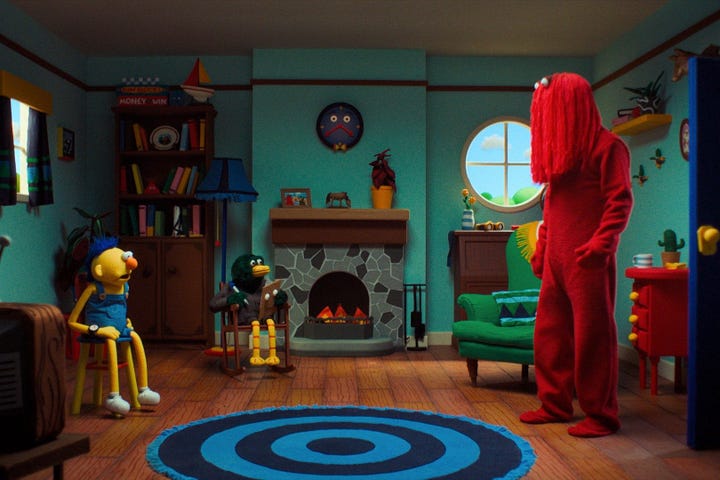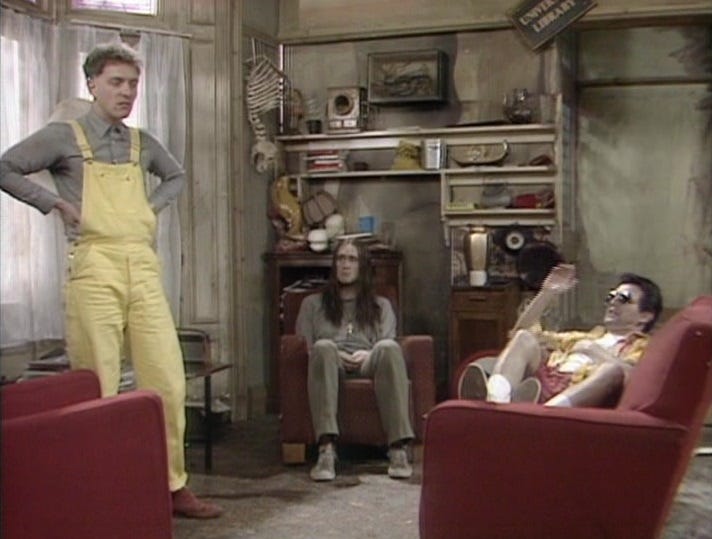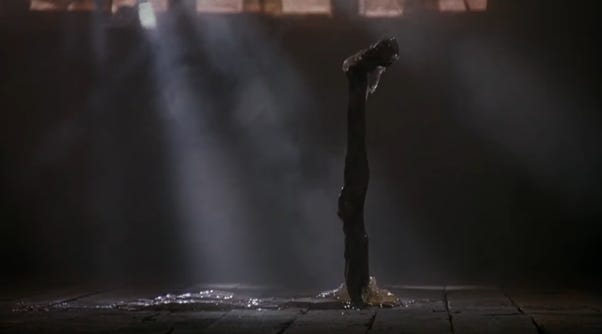Cuddly Death - A Coffin Comes to Life
Horror Moments (mini-series), 'Don’t Hug Me I’m Scared' Edition
‘Horror Moments’ is a weekly series examining horror-inflected scenes and themes in unexpected places. The ‘moments’ are published weekly on Thursdays, and I share articles on the history of magic, theatre, storytelling, and more on Mondays. Catch up with the recent Kate Bush series here and the full back catalogue of horror moments (from Wallace & Gromit to Shakespeare) here. Don’t forget to subscribe!
[Spoilers: Hellraiser (1987)]
Last week we began our journey through the terrifying world of ‘Don’t Hug Me I’m Scared,’ which started life as a YouTube short and then migrated to tv. There’s probably a horror moment a minute in the DHMIS universe, so I’ve had to be quite selective. I’ve also drawn heavily from the show rather than the shorts which I know is controversial since many people feel that the tv incarnation of DHMIS is much less compelling.
A common complaint is that the half hour episodes are far too strangely paced in comparison to the short sweet creepiness of the YouTube shorts. It’s a fair point, but before diving into today’s horror moment I wanted to offer a defence by way of comparison. Structurally and tonally, the DHMIS tv show reminds me a lot of the anarchic British comedy The Young Ones which aired in the 1980s and broke all the rules of pacing, narrative, and logic. There’s an almost antagonistic relationship between the show and its audience, it feels at times like we’re being dared to keep watching when the action is interrupted by something so surreal or inconsequential that it stretches the definition of a ‘comic’ scene to absurdist limits.
There are, for example, a lot of sentient household objects having their own small dramas in the corners of the filthy student flat where the show is set, a tomato living in amongst the long-forgotten vegetables in a fridge starts singing — and just keeps singing at us for half a minute for apparently no reason at all.
There are likewise loads of anthropomorphised puppet-objects in the longer episodes of DHMIS who are doing their own thing around the edges of the main action, like the urinal popping out for a cigarette during a fourth-wall break:
Both The Young Ones and DHMIS return each week to the malaise of characters who live together but resent each other. There is something of the contrast between The Young One’s frenetic and pretentious Rik and gloomy pacifist Neil in the arguments between Duck and ‘Red Guy.’


Both shows are about peering into a very weird house, meeting very weird people, and having any expectations about how you’re going to spend the next half an hour very much thrown out of the window. Neither feels like it’s been anywhere near a focus group, and I wouldn’t change a second of them despite their obvious ‘problems.’ The television incarnation of DHMIS is like The Young Ones thrown into a blender with all 90s children’s television and every horror film ever made.
Speaking of which…
I’m skipping to the second of the tv episodes for today’s horror moment, appropriately titled: ‘Death.’ In episode 1, our trio of colourful protagonists had been taught a lesson (sort of) about the importance of work. It had ended, naturally, with blood and mutilation, but the characters were returned home safe and sound enough.
Episode 2 breaks the DHMIS convention of leaving the gore for the climax. Right at the beginning, one of Duck’s organs falls out of his trouser leg and roly-polys along the floor until it dissolves into a pool of blood which sinks into the wooden floorboards.
Immediately, two spindly, fleshy arms rise up and heave a torso through the splintered wood…
Springing to life before their eyes is a sentient coffin, their ‘teacher’ for the week. “Hi, sorry about that, hey cool place!” he says, making polite small talk before congratulating Duck on the fact that he is dead.
You’ll have to watch the rest of the episode to find out exactly what happens but be prepared for the strangest of shaggy dog tales – and the sight of real maggots writhing in a puppet’s fur…
What I’m interested in here is the parallel between the staging of the coffin’s appearance and a horror film where drops of blood likewise give substance to something underneath the floorboards of a house. I’m thinking, of course, about the resurrection of Frank in Hellraiser (1987) which is closely mimicked by DHMIS.
If you don’t know Hellraiser, the basic gist is that a morally bankrupt thrill seeker, Frank, has opened up a magical puzzle box that has unlocked a terrifying parallel dimension. The creatures from this dimension are called cenobites (‘demons to some, angels to others’) who worship pain as a form of pleasure. They were inspired by writer Clive Barker’s experiences in BDSM clubs. They tear Frank to pieces but he is resurrected when blood is spilt on the spot in the attic where he died.
Well, I say ‘resurrected.’ Let’s just say he’s not entirely himself at first, he needs a good deal more blood to be spilt to give him his full substance again. Luckily for him, his sister-in-law, Julia, with whom he had been having an affair, is more than happy to bring him victims.
That initial instance of his reawakening, when he is little more than an extremely goopy skeleton, is the scene being referenced in DHMIS:
If you’re brave enough you can watch the whole thing here, a gorgeously disgusting example of how well practical effects age:
What both versions of the scene capture is the ancient belief that spilling blood has the power to summon something from the Other Side. In a strange twist, DHMIS does this not with a reincarnated corpse, but with a coffin. There’s an unexpectedly blunt truth to the logic here: bleeding out on the floor doesn’t lead to the reanimation of flesh but to…well…death.
There are loads of theories online about what the ‘Death’ episode means although I haven’t yet seen any that delve into this parallel with the Hellraiser reincarnation. For my money one of the cleverest elements of the episode as a whole is the way it sends up the absurdities of death and grief, particularly the sudden appearance in the kitchen of the grey-faced mourners whom the other characters have never seen before, standing around sobbing performatively and stroking photographs. They are offered the flimsy comforts of a tissue box who provides nothing but sandwiches and platitudes, a surreal reimagining of how funerals often make us feel.
Beyond that, I leave it up to you to decide what the episode means and whether there is any deeper significance to the Hellraiser reference. It often feels like DHMIS is deliberately encouraging pontification on symbolism that is meant to defy interpretation. For a horror fan, there’s enough pleasure to be had in spotting little Easter Eggs like this. Nasty, slimy, gory eggs.
Next week it’s time for family dinner! Until then, happy nightmares everyone.
Horror moments are posted every Thursday and a wide variety of articles exploring the history of magic, theatre, storytelling, and more are published on Mondays.









I had forgot about the DHMIS show until I came across this, and have been savouring each episode. I love (and hadn't made) the connection to The Young Ones, a show that was a big part of my childhood.
Not a horror fan, so I enjoy seeing the connections you are able to make to media I don't know. Hellraiser might just make my watchlist, now!
The Young Ones also had a kind of off-kilter creepy atmosphere at times, so it's a great comparison to make with DHMIS, and not one I'd considered. Just watch, 30 years from now, someone will discover another DHMIS character that just hung around in the background, like the infamous "fifth housemate" in TYO, sitting in the background like a Japanese ghost.